What is a human capital management system?
A Human Capital Management (HCM) system revolutionizes traditional HR functions throughout the employee life cycle, encompassing recruitment, training, payroll, compensation, benefits, and performance management.

Table of contents
- What is a human capital management system?
- Why is a human capital management system important?
- What are the benefits of a human capital management system?
- Human capital management Vs. human resource management
- What are the components of a human capital management system?
- What is HCM software?
- What practices does human capital management include?
- How to choose a human capital management system
- What is the future of HCM?
It transcends conventional administrative tasks, transforming them into strategic avenues for fostering engagement, enhancing employee productivity, and driving overall business value.
This comprehensive approach ensures that HCM systems streamline administrative responsibilities and strategically leverage each aspect of the employee life cycle to contribute significantly to organizational success.
Why is a human capital management system important?
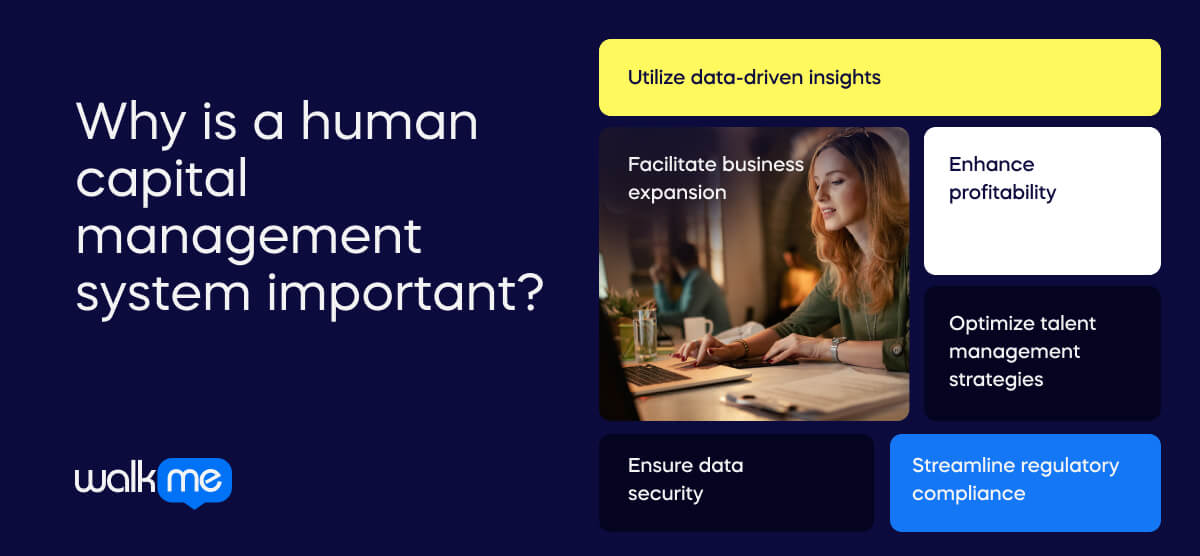
There are several reasons why a human capital management system is essential, beginning with how it helps you utilize data-driven insights.
Utilize data-driven insights
Leveraging predictive analytics and forecasting can result in more informed decisions regarding compensation packages, work schedules, and more.
Facilitate business expansion
Flexible and scalable cloud-based solutions enable efficient management of larger workforces, increased transactions, and extensive data.
Enhance profitability
Implementing automated workflows in place of manual tasks can reduce labor costs and administrative expenses.
Optimize talent management strategies
Leverage technology such as chatbot-assisted applicant screenings, multimedia-based training, and mobile self-service options to attract and retain top talent effectively.
Ensure data security
Implement multi-layered protection and proactive security alerts to safeguard against data breaches and fraudulent activities.
Streamline regulatory compliance
Leverage global and local monitoring capabilities to stay up-to-date with the evolving governance process and ensure compliance.
What are the benefits of a human capital management system?
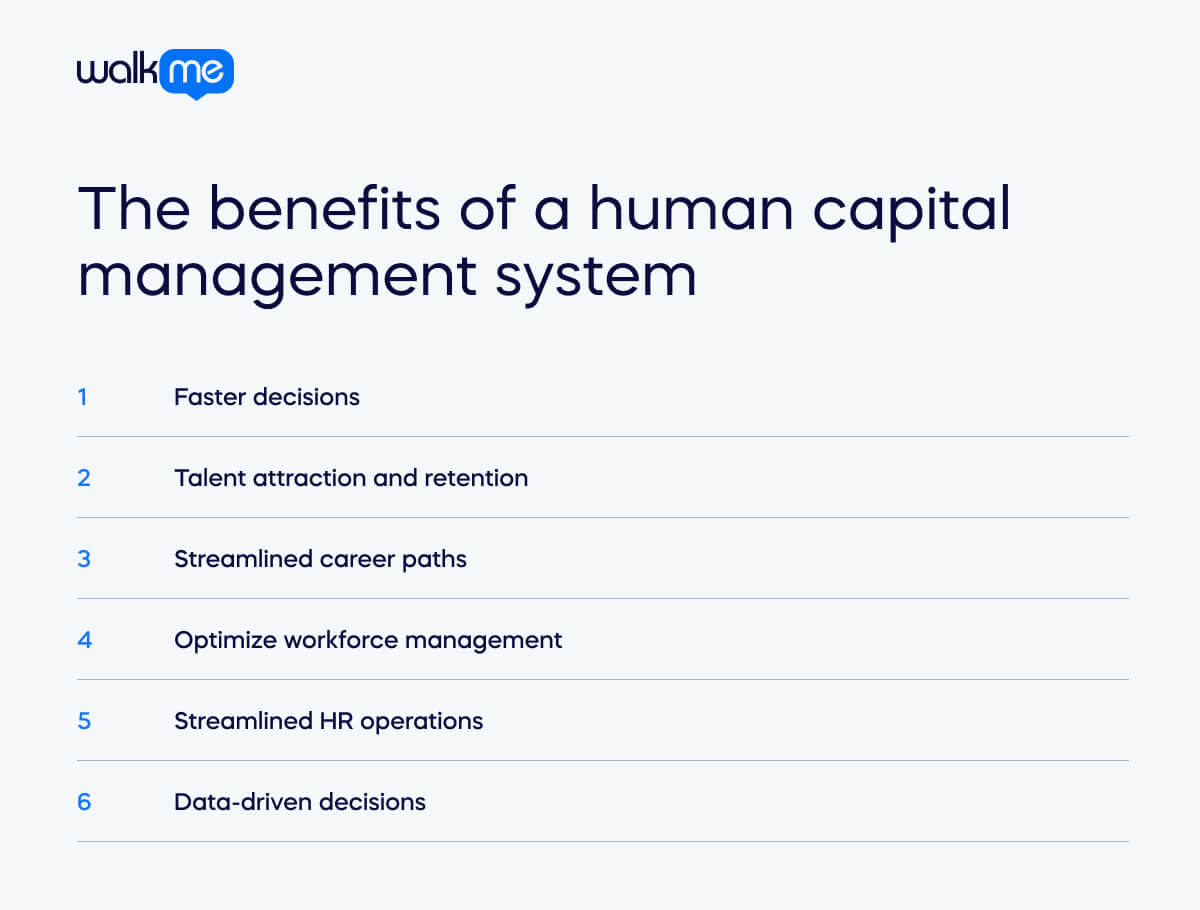
Consider these benefits to ensure you need a human capital management system.
HCM transforms HR administrative functions into opportunities to drive engagement, productivity, and business value.
It involves various functions, including job management, compliance, reporting, workforce management, and workforce rewards, which you can optimize through advanced technologies like AI and chatbots.
A human capital management software solution automates various stages of the employee journey, including core HR operations, talent development, talent management, HR analytics, and compliance management.
Faster decisions
HCM solutions help businesses make smarter decisions faster, deliver a best-in-class employee experience, and engage quickly.
Talent attraction and retention
HCM software plays a crucial role in attracting talent and employee retention.
It enables businesses to increase hiring speed and quality by quickly sourcing and recruiting suitable candidates, engaging employees through work-life solutions, and providing employee training and growth opportunities to retain and nurture talent.
Streamlined career paths
HCM solutions also help businesses increase bench strength by proactively planning for succession in leadership and other vital roles, aligning people strategy with business strategy, and adjusting the workforce quickly to organizational changes.
Optimize workforce management
HCM solutions optimize workforce management and spending by differentiating compensation, managing time and labor, scheduling and related expenses, maintaining specific projects and other costs, and building a pay-for-performance culture.
Streamlined HR operations
HCM software streamlines HR operations by consolidating disparate HRMS (human resources management system), leveraging analytics for more intelligent workforce decisions, automating manual processes globally and locally, and accelerating HR processes with self-service.
Data-driven decisions
Ultimately, HCM solutions involve data-driven decision-making, business growth facilitation, profitability increase, talent strategy optimization, data security, and regulatory compliance improvement.
Human capital management Vs. human resource management
Exploring the distinctions between Human Capital Management (HCM) and Human Resource Management (HRM) reveals detailed differences in their approaches to workforce administration.
Human capital management
HCM adopts a holistic perspective, valuing employees as assets and aligning practices with overarching business goals.
Beyond traditional HR functions, it encompasses talent management, workforce planning, and development, strategically addressing present and future talent needs.
Human resource management
Conversely, HRM executes strategies identified in HR planning, emphasizing day-to-day functions like recruitment, training, and performance management.
It ensures optimal staff placement through effective hiring and development practices, operating within a narrower scope than the comprehensive outlook of HCM.
What are the components of a human capital management system?
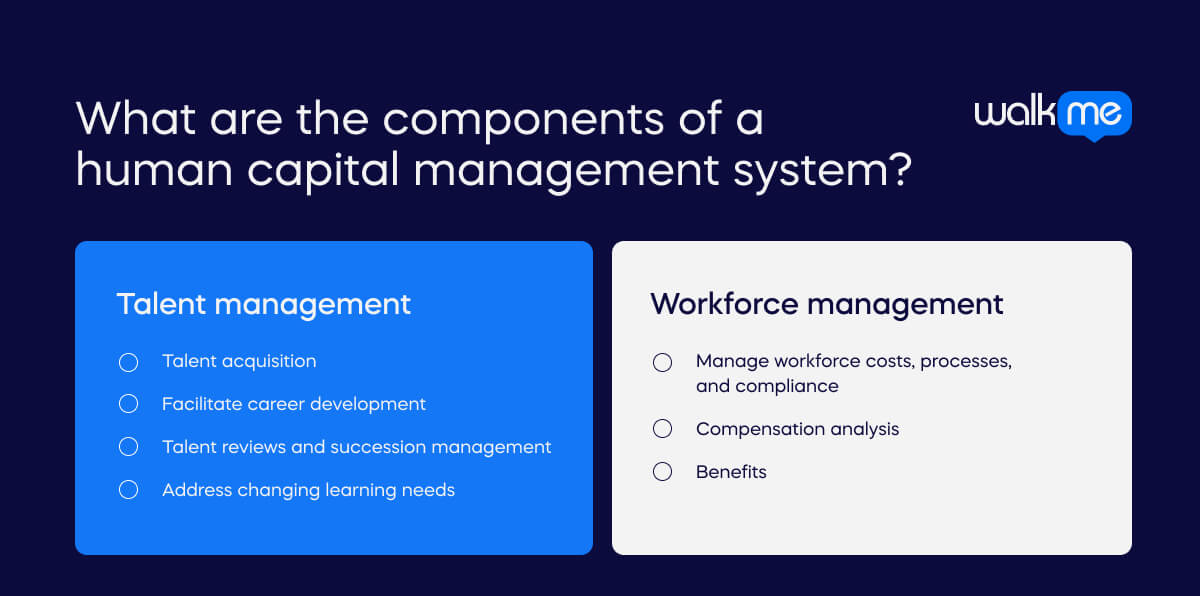
Streamline your HRIS systems to oversee your entire workforce using a unified, global system of record.
Talent management
Optimize talent management by empowering organizations to navigate the entire talent lifecycle.
Human capital management system is capable of talent management features like:
- Efficiently sourcing and recruiting
- Seamlessly onboarding new hires
- Overseeing goals and performance
- Recognizing achievements
- Benefits administration
- Facilitating continuous learning
- Fostering career development
- Orchestrating talent reviews and succession planning
Talent acquisition
Elevate talent acquisition with a candidate-centric experience, utilizing cutting-edge technologies to match the most suitable candidates with available positions.
Performance management
Enhance performance improvement and management by aligning individual and business goals, offering regular checkpoints to optimize performance, and supporting employees.
Facilitate career development
Facilitate career development by identifying opportunities and maintaining development plans that bring employees closer to their career aspirations.
Talent reviews and succession management
Conduct talent reviews and succession management by assessing macro-organizational talent trends and proactively planning for future leadership and critical roles.
Address changing learning needs
Address the learning needs of the modern workforce, keeping employee skills current through a tailored learning experience powered by embedded intelligence.
Workforce management
An HCM can also assist with many workforce management tasks, such as labor costs, processes, and global compliance.
Manage workforce costs, processes, and compliance
Efficiently manage your workforce by overseeing labor costs, streamlining manual processes, and ensuring global compliance for all employees.
Compensation analysis
Delve into compensation with in-depth analysis, modeling, budgeting, and local and global compensation plan administration.
Implement a pay-for-performance approach by integrating performance ratings, goal attainment, and other metrics into compensation calculations.
Benefits
Enhance workforce rewards to attract and retain talent, driving value through a differentiated rewards strategy. Utilize modern and innovative technology to maximize the accuracy of payroll and compensation data.
Optimize benefits by delivering flexible program options that adapt to unique business needs.
What is HCM software?
HCM software integrates technologies to streamline employee management, covering the entire lifecycle from hiring to retirement. One example is Workday human capital management.
HCM software backs various HR functions—recruitment, talent management, payroll, and benefits. Accessible in the cloud or on-premises, it trims costs, boosts access, enhances the employee experience, and fortifies record security.
Managing employee records in a database, top HCM cloud providers provide advanced analytics for valuable insights into optimal employee management.
What practices does human capital management include?
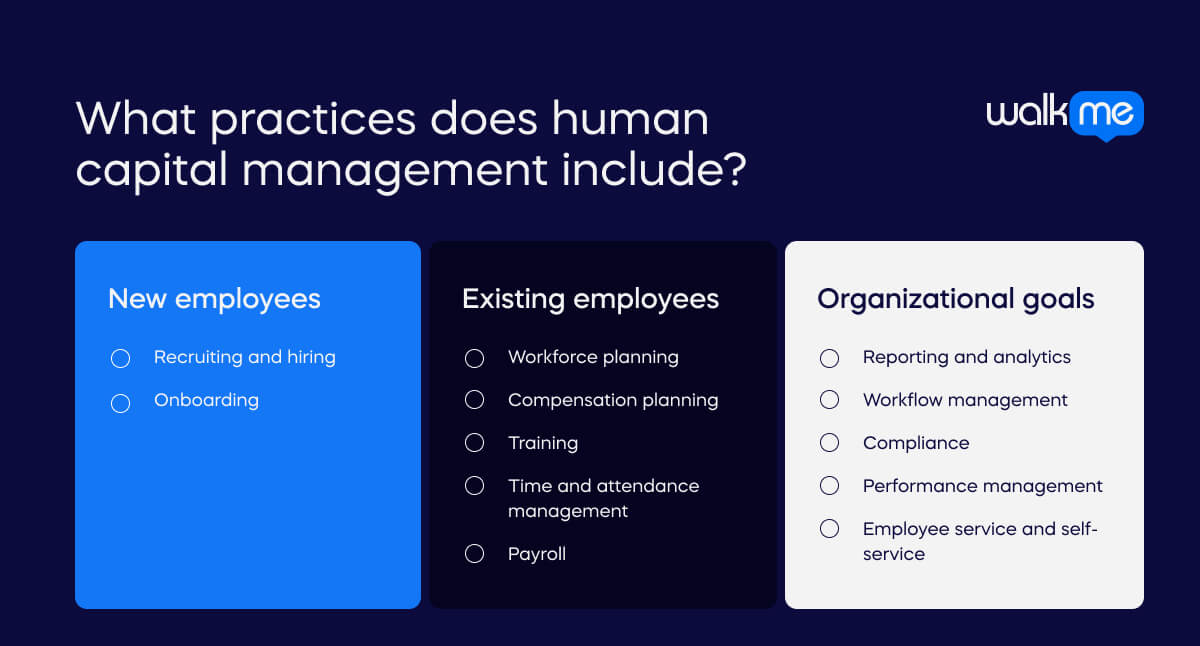
Human capital management systems support many practices.
These practices are divided into three sections—existing employees, new employees, and organizational goals, including the following:
New employees
- Recruiting and hiring: HCMs support identifying, attracting, and selecting qualified candidates to fill organizational roles via automation.
- Onboarding: Integrating and orienting new employees into the workplace, fostering a smooth transition using an HCM checklist.
Existing employees
- Workforce planning: Strategically aligning organizational goals with staffing needs to optimize human resources.
- Compensation planning: The systematic process of designing, implementing, and updating a fair and competitive employee remuneration structure.
- Training encompasses planned activities to enhance employees’ skills, knowledge, and capabilities to meet job requirements.
- Time and attendance management: Track and monitor employees’ work hours to ensure accurate payroll and compliance.
- Payroll: The systematic calculation and distribution of employees’ wages, salaries, and benefits.
Organizational goals
- Reporting and analytics: HCMs offer a variety of tools for collecting and analyzing data to gain insights into various aspects of human capital management.
- Workflow management: An HCM can help you focus on optimizing and streamlining business processes to improve efficiency and productivity using tools to optimize specific processes.
- Compliance: HCMs help ensure adherence to legal and regulatory requirements governing employment practices and workplace policies by recording policies and automatically providing updates according to local laws.
- Performance management: HCMs help HR staff to assess and enhance employees’ performance by keeping detailed records of feedback, goal setting, and development plans employees can access whenever they choose.
- Employee service and self-service: The best HCM tools provide support and resources to employees while empowering them to independently manage certain aspects of their employment.
Knowing these practices can help you understand how an HCM can work alongside your current practices, enhancing and optimizing them to save resources, retain staff, and increase sustainability.
How to choose a human capital management system
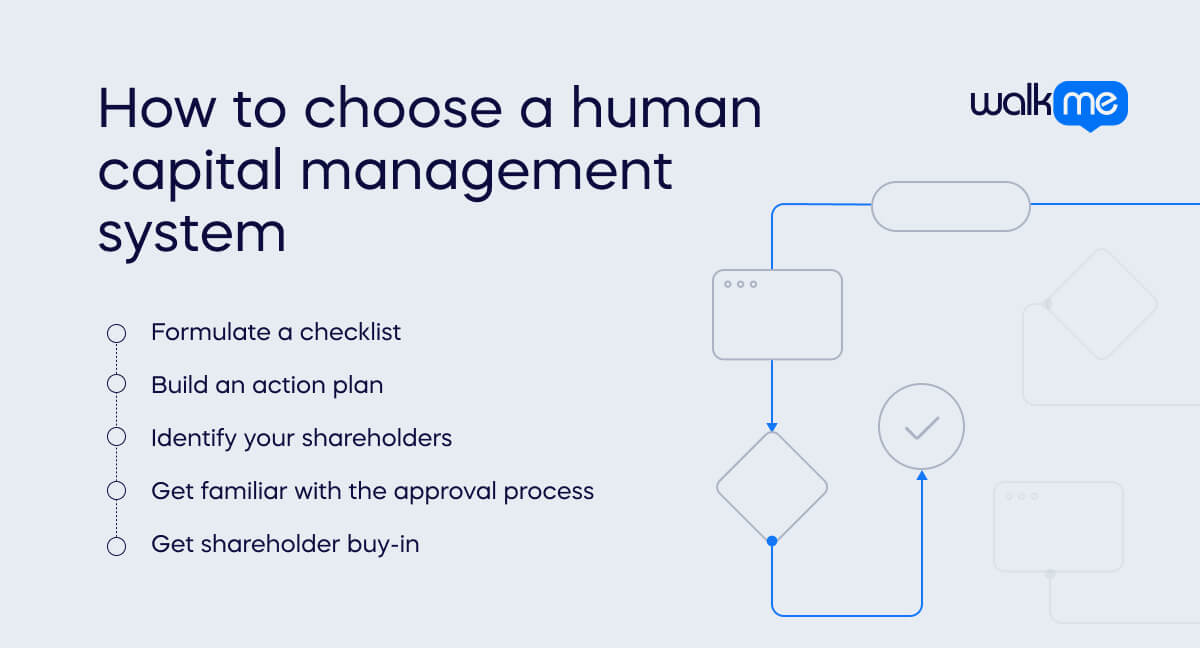
Selecting the appropriate HCM partner for your organization might seem challenging, but it’s attainable through a focused, organized, and strategic purchasing process.
1. Formulate a checklist
Develop a checklist of requirements delineating the business goals tied to HCM and the potential impact on your organization if these goals are unmet. This checklist will assist in assessing HCM solutions that align best with your needs.
2. Build an action plan
Build an action plan encompassing project scope, required resources, budget, and team leaders.
3. Identify your shareholders
Identify the internal stakeholders most affected by the project and ensure continuous communication with them.
4. Get familiar with the approval process
Familiarize yourself with your organization’s approval process for transformative projects and outsourced solutions.
5. Get shareholder buy-in
Ensure your stakeholders approve of any potential new HCM by presenting the solution and emphasizing its business, financial, and end-user benefits. Utilizing an HCM business case template can be instrumental in making a compelling argument.
Use these steps to help you find the best HCM for you that fits in with your approval process and the needs of your shareholders to avoid wasting resources and ensure success.
What is the future of HCM?
Technology is reshaping HCM, altering strategies, redefining roles, and ushering in new opportunities.
As organizational structures transition towards flatter, agile team networks with enhanced mobility, global reach, and diversity, HCM is evolving rapidly. It integrates familiar technologies like SaaS and mobile applications while embracing cutting-edge advancements like machine learning and AI.
Future developments in HCM systems are poised to incorporate AI to augment human capabilities, efficiently sifting through vast datasets for optimal candidate identification.
Seamlessly integrating ChatBots ensures expedited responses, guaranteeing swift and efficient service. Mobile capabilities take engagement and productivity to new heights, empowering HR, workers, and managers with intuitive self-service applications.
Social media collaboration has also become a pivotal tool, cultivating interactions among peers and mentors. A vigorous approach accelerates responsiveness and creates a vibrant, collaborative environment, ultimately enriching organizational productivity.